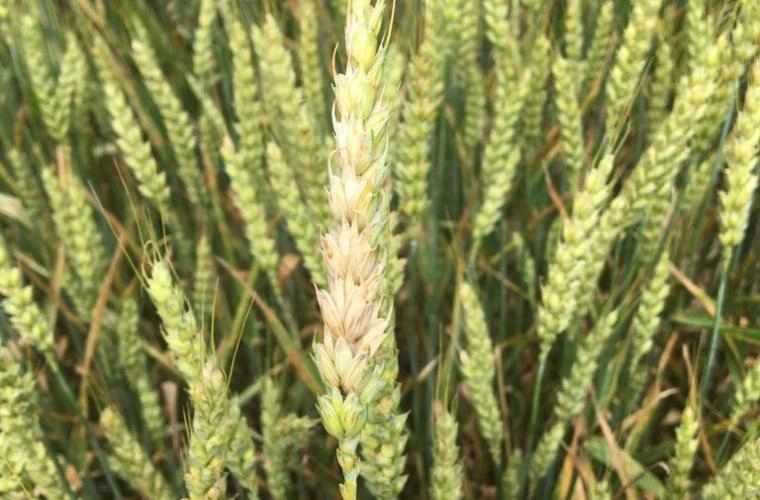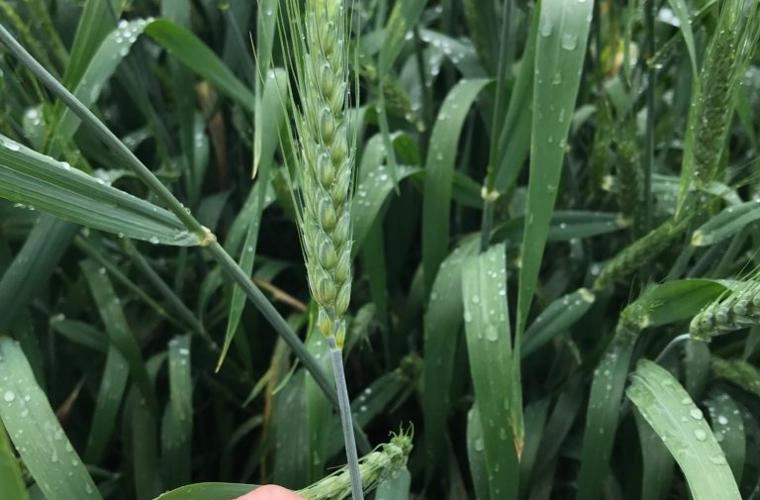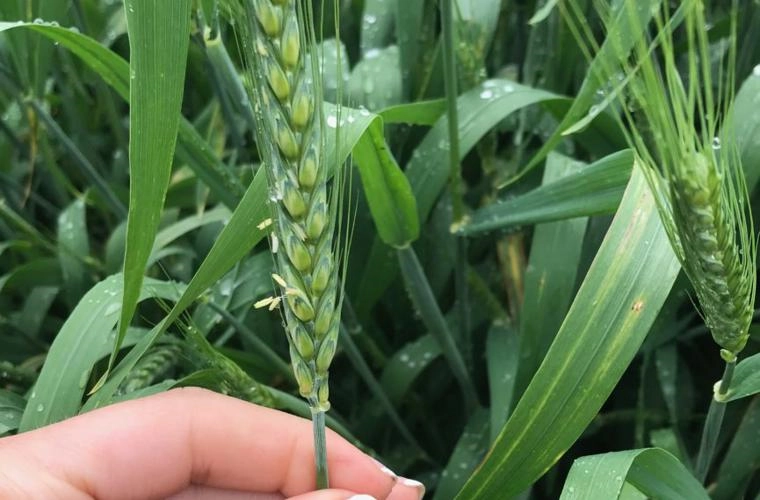Summary
Wheat is most susceptible to fusarium head blight (FHB) infection during the flowering period. Spores are carried from infected crop residue by wind or rain and splash onto the wheat head. Rainfall or heavy dew during this period then causes the spores to germinate and infect florets on the wheat head.
Identification
Symptoms of FHB become noticeable soon after flowering. Diseased spikelets (glumes and florets) appear to have ripened prematurely (bleached) in contrast to healthy, green heads. The fungus may attack all or only part of the head. FHB symptoms can occur under favourable conditions 3-5 days after infection which later leads to bleaching of heads (figure 1). The entire head may be killed when the neck (the stem immediately below the head) is infected. During warm, humid weather, the fungus produces a salmon-orange-to-pink ring of spores at the base of the spikelet or in the crease of the kernel. If conditions continue, the infection may spread to adjacent kernels. Infected kernels are usually shrunken, wrinkled and light in weight. These kernels have a rough, scabby appearance and range in colour from light brown to pink to greyish-white. The amount of scab on the seed depends on the time of infection and the weather conditions at the time of infection.

Biology
Although several species of Fusarium can cause scab or FHB, the principal pathogen is Fusarium graminearum, which can infect corn, wheat, barley, oats and rye. All species overwinter in infected kernels, chaff, stubble or straw/stalk residues left on the soil surface. They survive between crops as asexual spores (conidia), fungal strands (mycelium) and within dark purplish-black fruiting bodies (perithecia), which the sexual spores (ascospores) are borne in. The fungi will continue to grow and produce spores from harvest until the crop residues have decomposed in the soil. Both types of spores can be carried from infected residues of the previous crop by wind or rain splash onto the wheat head. The conidia are produced during warm, moist weather on corn and small grain residues while the ascospores are released during wet and dry cycles. By doing so, the fungus is able to spread spores into the air for a longer period of time. Spores that land on the head require rainfall or heavy dew to germinate and invade flower parts (anthers), glumes and other portions of the head. The potential for disease increases substantially when these spores land during an extended warm period at temperatures between 22°C–27°C with wet, humid weather. The longer it stays wet during flowering, the greater the chance of infection and therefore increased disease severity. If warm, moist weather continues, the salmon pink spore masses produced on the spikelets will be air-borne and can act as another source of infection.
The planting of infected seed can result in the development of the seedling blight phase of the disease, which is separate from scab. Infected kernels may not germinate and can result in poor stands. Infected plants that emerge may lack vigour and will often die before they become established. Infected seedlings can appear light-to-reddish-brown and may be covered with a white or pink mould. As the plants mature, they are usually smaller with few tillers and small heads. If the root or crown is cut, a light-to-reddish-brown root rot can be observed.
Best Management Practices
Crop Rotation
Avoid planting wheat following wheat or corn. When residues of either of these crops are left on the surface and wheat is subsequently planted, the chances of FHB infections are greatly increased.
Tillage
Clean plowing of infected residues reduces the risk of infection from spores originating from within the field. However, FHB may still develop from spores blown in from surrounding fields under weather conditions favourable to disease development.
Variety Selection
If possible, avoid planting varieties that are susceptible to FHB. If you do plant a susceptible variety, your risk of FHB infection is greater and a preventative fungicide application is recommended.
Due to the significant impact FHB can have on the Ontario wheat sector, FHB and DON are key parameters that are assessed every year in the Ontario Cereal Crop Committee (OCCC) Performance Trials. Scores for both Fusarium index and DON by growing area are available for growers to view in the performance trial results.
Foliar Fungicides
The OMAFA Crop Protection Hub provides a list of foliar fungicides labelled for the suppression or control of fusarium head blightt.
When should a preventative fungicide be applied?
Once 75% of wheat heads on the main stem reach GS59 (head emergence complete) this is known as “day 0” (figure 2). The optimum fungicide application timing is shortly after this on “day 2” (figure 3). Day 2 is the beginning of pollination when anthers are visible on the middle of the wheat head. This timing is critical because this is when the peak number of florets are open and susceptible to infection. If temperatures are warm during this period it could result in the wheat crop moving quickly through these growth stages so it will be important to track the staging of your wheat crop as it approaches heading (GS59).


Timing of applications is difficult when there is a lack of uniformity in fields. While day 2 is the optimum time, T3 fungicides can be applied up to day 6 with good efficacy. Therefore, waiting an extra day or two and targeting day 3-6 may allow you to target more of the crop at the optimum time. Two fungicide applications are not recommended as they are generally not economical, particularly in those fields with low yield potential.
Assess Risk for FHB and DON Before Harvest
Assessing the level of infection in winter wheat fields to help prioritize harvest plans, is critical to maximizing quality and minimizing DON. To conduct an assessment, blindly grab 10 heads and count the number of heads with any level of infection to give the percent incidence (e.g. 1 head out of 10 infected = 10% incidence). From there the percent severity can be estimated by looking at how much of the head is infected (e.g. 6 spikelets infected out of 22 = 27% severity). The incidence is then multiplied by the severity and is divided by 100 (e.g. 10 x 27 = 270/100 = 2.7 Fusarium Index). Repeat this process at 10 locations in the field to arrive at a field level FHB index. In work published by Falk, D. et al, 2008, a fusarium index of 3 could result in DON levels >6 ppm in a high pressure fusarium year. If fields have a FHB index of greater than 2 they should be prioritized at harvest.
Combine Set-up
As many of the infected kernels are small, shrunken and lighter than sound kernels, it is possible to blow a large proportion of these kernels out the back of the combine by increasing the air blast above normal ranges. This may cause some additional loss of good kernels (up to 0.13 t/ha or 3 bu/acre).